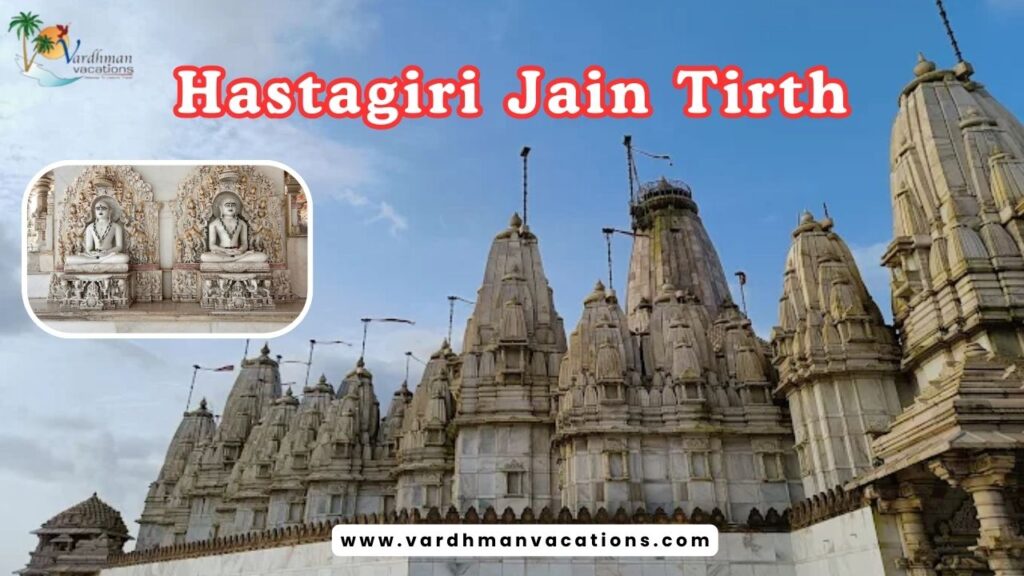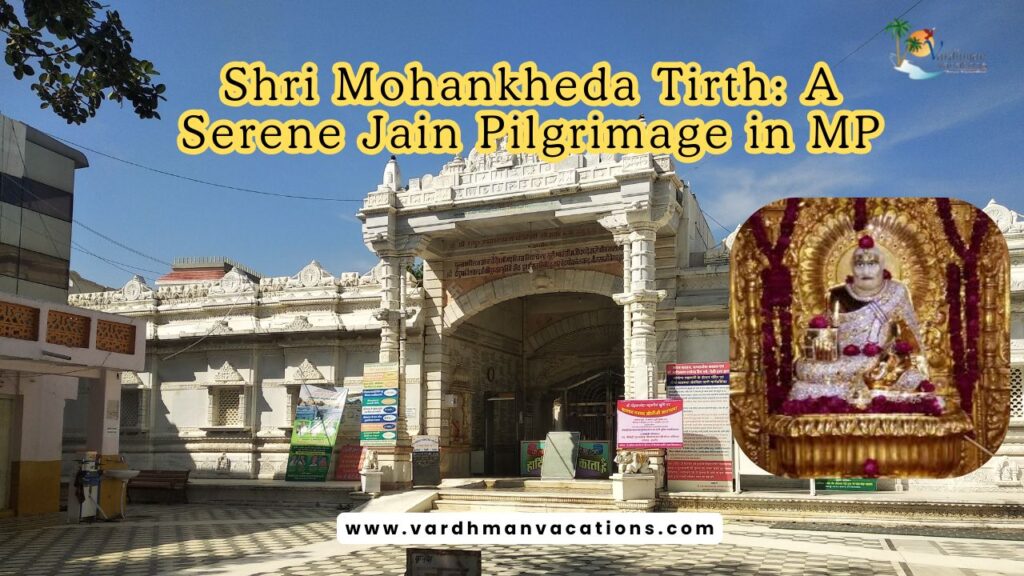Rajgir, formerly known as Rajagriha, is a historically and spiritually significant town in Bihar’s Nalanda district. Surrounded by five hills—Baibhar, Vipul, Ratnagiri, Udaygiri, and Songiri—Rajgir served as the capital of Magadha King Jarasandha, a prominent figure also mentioned in the Ramayana. In earlier times, it was known as “Giribraja” and is still referred to as Panchpahari, meaning “five hills.”
A Center for Buddhism and Jainism
Rajgir is closely associated with both Buddhism and Jainism. Emperor Bimbisar of the Maurya dynasty was converted to Buddhism here when Lord Buddha visited Rajagriha. The Buddha spent 12 years in Rajgir, meditating and teaching.
Footprints of the Buddha in Rajgir

Rajgir holds a special place in the life of Gautam Buddha. It was here that Emperor Bimbisar first encountered the Buddha and later became his follower. The Buddha spent 12 years meditating and teaching in Rajgir. Important Buddhist sites here include:
- Gridhrakut Hill – Buddha’s monsoon retreat and teaching center
- Venuban Vihar – A monastery built by Bimbisar for Buddha’s stay
- Saptaparni Cave – Site of the First Buddhist Council, held after Buddha’s Mahaparinirvana
Rajgir and Jainism: Sacred Ground for Tirthankaras
Jainism also holds Rajgir in high regard. The 20th Jain Tirthankara, Munisuvratnath, was born here, while Lord Mahavir, the 24th and last Tirthankara, stayed here for 14 monsoons. Mahavir delivered his first religious discourse on Vipul Hill, where a Digambar Jain temple now stands. Steps from Saptarshi Kund lead to the 1800-foot-high peak of Vipul Hill, which can be explored in about an hour.
Modern-Day Rajgir: Hot Springs and Healing Waters

Today, Rajgir is famous for its natural hot springs, most notably at Saptarshi and Brahmakund, located southeast of Venubana across the Saraswati River. These sacred waters emerge from seven different streams, each varying in temperature.
- The most revered is Brahmakund, believed to be created by Lord Brahma’s meditation, with a temperature of 45°C.
- Other notable springs include Satadhara, Shaligram, Saptarshi, Sitaram, Ganesh, and Suryakund.
The hot sulphuric water is known to cure skin ailments and rheumatism, but precautions such as avoiding hot water on the head for more than 5 seconds, or bathing on an empty stomach, should be followed.
Ajatsatru’s Fort and the Story of Bimbisar

The historical Ajatsatru Fort was built by King Ajatsatru, son of Bimbisar, around 500 BCE. Though only one of its 32 gates is visible today, the massive double walls and rock-cut moat remain impressive. The Ajatsatru Stupa, built on a 6.5 sq. m land, is believed to have preserved a nail of Buddha.
In a tragic twist, Bimbisar was imprisoned by his own son. The Jail of Bimbisar, built with thick 1.8m walls, is still preserved. From the prison, Bimbisar could see Buddha meditating on the nearby Gridhrakut Hill, a place he visited often before his assassination in 490 BCE.
Mythology Comes Alive: Bhim vs. Jarasandha

Rajgir also has strong mythological ties. At the Akhara (wrestling arena) of Jarasandha, the second Pandava, Bhim, is believed to have wrestled and killed King Jarasandha after 28 days. Close by is the mysterious Son Bhandar (Gold Treasury), where legends say hidden treasures lie behind an undeciphered cave wall inscribed with 32 ancient symbols.
Venuban Vihar: Bimbisar’s Gift to the Buddha

King Bimbisar offered his pleasure garden to Buddha, who lived here during several monsoon seasons. Today, Venuban has been transformed into a peaceful Deer Park and Zoo, and excavations have revealed the historical foundations of the original monastery.
Gridhrakut Hill: Buddha’s Monsoon Retreat

To the north lies the majestic but rugged Gridhrakut Hill, where Buddha taught for three months every monsoon. The hill has two caves and a demolished courtyard where Buddha lived with his disciples. It is also believed that this is where Sujata offered sweets to Buddha and where King Bimbisar gave up violence.
First Buddhist Council and the Japanese Peace Pagoda

Following Buddha’s Mahaparinirvana, the First Buddhist Council was held at the Saptaparni Cave on Baibhar Hill, 12 km south of Rajgir, under the patronage of King Ajatsatru. To commemorate this, the Japanese Buddhist Council constructed the stunning Bishwa Shanti Stupa (Peace Pagoda) atop Ratnagiri Hill.
- Built in 18 months at the cost of Rs 18 lakh, the white stupa stands 125 ft high with a 144 ft base.
- Visitors can reach it via a 600-meter-long electric ropeway, offering a 15-minute scenic ride.
Temples and Other Tourist Attractions in Rajgir

Apart from Buddhist sites, Rajgir also houses numerous Jain temples belonging to both Swetambar and Digambar sects. In addition to its spiritual legacy, Rajgir offers several fascinating tourist spots that blend nature, history, and adventure:
Griddhakuta Hill (Vulture’s Peak)
A sacred Buddhist site where Lord Buddha meditated and delivered sermons during the monsoon season. It is also believed to be the site where Buddha accepted food from Sujata and met King Bimbisara.
Venuvan (Bamboo Grove Monastery)
Gifted by King Bimbisara to Lord Buddha, this was one of the first monasteries built for his disciples. Today, it serves as a peaceful Deer Park and spiritual retreat.
Japanese Peace Pagoda (Vishwa Shanti Stupa)
A snow-white dome-shaped stupa built by Japanese monks on Ratnagiri Hill to mark the 2500th anniversary of Buddha’s Mahaparinirvana. It is accessible by a thrilling ropeway ride and features golden Buddha statues depicting key life events.
Ajatshatru Fort
These ancient 6th-century BCE ruins were built by King Ajatshatru, son of Bimbisara. The fort once had 32 gates; now only one survives, along with remnants of its massive double walls.
Bimbisara Jail
A poignant historical site where King Bimbisara was imprisoned by his own son, Ajatshatru. It’s believed he could see Lord Buddha meditating from his cell on Griddhakuta Hill.
Cyclopean Wall
An extraordinary 2,500-year-old stone wall that once surrounded the ancient city of Rajgriha. It’s made of large, uncemented stones and stands as a marvel of ancient engineering.
Rajgir Ropeway
One of the oldest ropeways in India, this open-air chairlift offers a panoramic ride to the Japanese Peace Pagoda atop Ratnagiri Hill. It’s both scenic and thrilling.
Hot Springs (Brahmakund)
Located near Saptarshi Kund, these sacred hot springs are believed to have healing properties due to their sulphur content. Each stream varies in temperature, and the site includes changing rooms and shrines.
Jain Temples on the Five Hills
Devotees often trek up the five hills surrounding Rajgir—Vipul, Baibhar, Ratnagiri, Udaygiri, and Songiri—to visit Digambar and Shwetambar Jain temples, many of which are dedicated to Lord Mahavir.
Swarna Bhandar (Son Bhandar Caves)
A pair of Jain caves believed to be part of King Jarasandha’s hidden treasury. Legend says that the treasure is sealed behind a rock wall inscribed with undeciphered ancient scripts.
Rajgir Glass Bridge (New Attraction)
A modern skywalk made of glass, located in the Nature Safari Park. This exciting new addition offers breathtaking views of the forests and hills—perfect for thrill seekers and photographers.

Travel Tips for Rajgir Visitors
- Best time to visit: October to March, when the climate is pleasant
- Hot spring bath caution: Avoid bathing on an empty stomach and take proper rest after bathing
- Clothing: Carry warm clothes in winter and follow traditional etiquette at temples
- How to reach: Rajgir is accessible by road and train. The nearest airport is in Patna (~100 km)
Conclusion: A Living Heritage Site
Rajgir is more than a tourist destination—it’s a living museum of India’s ancient spiritual heritage. Whether you come for healing, meditation, or mythological exploration, Rajgir promises a journey that is as enriching as it is unforgettable.
Frequently Asked Questions (FAQ) about Rajgir
Rajgir is famous for its religious, historical, and natural significance. It was the ancient capital of Magadha and is associated with Buddhism, Jainism, and Hindu mythology. It features sacred hills, hot springs, Buddhist monasteries, Jain temples, and mythological sites like Jarasandha’s Akhara.
The best time to visit Rajgir is between October and March, when the weather is pleasant and ideal for sightseeing, hiking, and hot spring baths.
By Air: The nearest airport is Patna (100 km).
By Train: Rajgir has its own railway station with connectivity to major cities.
By Road: Regular buses and taxis operate from Patna, Nalanda, Bodh Gaya, and Gaya.
Some of the must-visit attractions include:
Vishwa Shanti Stupa (Peace Pagoda), Ajatsatru Fort & Bimbisar Jail, Gridhrakut Hill, Hot Springs at Brahmakund & Saptarshi Kund, Venuban Vihar, Vipul Hill & Jain Temples, Son Bhandar Caves
Yes, Rajgir is sacred for Jain pilgrims. It is the birthplace of the 20th Tirthankara, Munisuvratnath, and a place where Lord Mahavir spent 14 monsoons and gave his first sermon on Vipul Hill.
Yes, tourists and pilgrims often bathe in the sulphur-rich hot springs, believed to have therapeutic properties. However, follow bathing guidelines for safety—avoid pouring hot water on your head for more than 5 seconds and don’t bathe on an empty stomach.
Yes, the electric ropeway to Ratnagiri Hill is operational and safe, offering stunning views of Rajgir. It operates in two shifts and takes about 15 minutes for a round trip.
Yes, Rajgir offers various hotels, guesthouses, dharamshalas, and tourist bungalows to suit all budgets. For spiritual travelers, Jain and Buddhist accommodations are also available.






